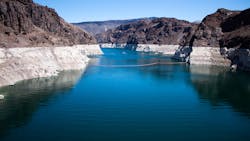Texas A&M researchers have created a new dataset that quantifies trends of evaporative water loss from 1.4 million global lakes and artificial reservoirs
Led by Dr. Huilin Gao, associate professor in the Zachry Department of Civil and Environmental Engineering at Texas A&M University, researchers created the global lake evaporation volume (GLEV) dataset. It leverages modeling and remote sensing to provide the first long-term monthly time series for 1.42 million individual natural lakes and artificial reservoirs worldwide.
The researchers published their findings in Nature Communications.
About 87 percent of fresh surface water in liquid form is stored in natural and artificial lakes (i.e., reservoirs). While the evaporation volume from these global lakes is substantial, little is known about its spatial distribution and its long-term trend.
From 1985 to 2018, researchers discovered that long-term average lake evaporation volume has increased at a rate of 3.12 cubic kilometers per year. The trend attributions include an increased evaporation rate of 58 percent, decreased lake ice coverage of 23 percent and increased lake surface area of 19 percent.
The results from the study underline the importance of using evaporation volume (rather than evaporation rate) as the primary index for assessing climatic impacts on lake systems.
“We found that the long-term lake evaporation is 1,500 plus or minus 150 cubic kilometers per year, which is 15.4 percent larger than previous estimates,” said first author Dr. Gang Zhao, a Texas A&M former student who is now a postdoctoral fellow in the Department of Global Ecology at the Carnegie Institute for Science. “This suggests that lake evaporation plays a larger role in the hydrological cycle than previously thought.”
According to GLEV, 6,715 reservoirs only account for five percent of the water storage capacity and 10 percent of the surface area of all lakes (both natural and artificial). However, reservoirs contribute 16 percent to the evaporation volume. This quantity of reservoir evaporative loss is equivalent to 20 percent of the global annual consumption of water use. In the last 33 years, evaporative water loss from reservoirs has been increasing at a rate of 5.4 percent per year, outpacing the global trend of 2.1 percent for all lakes.
"With regard to evaporation loss, this study will be an invaluable venue to serve water resources researchers and decision-makers," Gao said. "Our findings have significant environmental, societal and economic implications as the global evaporative loss will be accelerated and further exacerbated in the future under global warming.
Without accurately quantifying the magnitude and trend of volumetric evaporation loss individually for the millions of global lakes, researchers say reliable water and energy resources projections can't be made. This freely available dataset can benefit decision-makers and the wider science community.
For future work, Texas A&M researchers, the Desert Research Institute, and the U.S. Bureau of Reclamation recently started a nearly $1 million NASA Applied Science project that focuses on developing satellite-assisted, operational, daily reservoir evaporation monitoring and forecasts for the Western United States. The team will also expand an ongoing daily reservoir monitoring project for Texas.



